In the quest to stabilize the power grid and harness the full potential of offshore wind farms, researchers have turned to a powerful ally: energy storage systems. A recent study published in the journal *Energies* by Xin Lin of the Power Grid Planning Research Center at Guangxi Power Grid in China, sheds light on how to optimize these systems for maximum efficiency and economic viability.
Offshore wind farms are a critical component of the renewable energy mix, but their intermittent nature poses challenges to grid stability. Energy storage systems can smooth out these fluctuations, but balancing the cost of these systems with their benefits has been a persistent hurdle. Lin’s research tackles this issue head-on, proposing three different energy storage configuration strategies and employing a sophisticated algorithm to find the sweet spot between cost and performance.
The non-dominated sorting genetic algorithm (NSGA-II) is a powerful tool for multi-objective optimization, and Lin’s study demonstrates its effectiveness in this context. “NSGA-II performed stably in dual-objective scenarios and effectively balanced the relationship between the investment cost of the energy storage system and power fluctuations,” Lin explains. This balance is crucial for making energy storage systems a viable option for offshore wind farms.
The study found that when considering only the investment cost of the energy storage system, the optimal configuration was a rated power of 4 MW and a rated capacity of 28 MWh. This setup strikes a balance between investment economy and power fluctuation, providing a cost-effective solution for grid stabilization.
However, the story doesn’t end there. Lin’s research also explored the potential of energy storage systems to participate in the electricity spot market. By employing a fixed-period electricity price arbitrage method, the economic efficiency of the energy storage systems could be significantly improved. In this scenario, the optimal configuration shifted to a rated power of 8 MW and a rated capacity of 37 MWh, with a project investment cost of CNY 242.77 million. Moreover, the annual fluctuation rate of the wind power output decreased to 17.84%, a testament to the system’s effectiveness.
This research has significant implications for the energy sector. As Xin Lin notes, “The economic efficiency of the energy storage systems could be significantly improved through the fixed-period electricity price arbitrage method.” This finding could pave the way for more widespread adoption of energy storage systems in offshore wind farms, enhancing grid stability and facilitating the transition to renewable energy.
The study also highlights the importance of considering the battery life of the energy storage system in the optimization process. By analyzing the correlation between the rated power and rated capacity of the energy storage system and the battery life, Lin’s research provides a more comprehensive approach to system design.
As the energy sector continues to evolve, research like Lin’s will be instrumental in shaping the future of offshore wind power. By optimizing energy storage systems for both cost and performance, we can unlock the full potential of renewable energy and build a more stable, sustainable grid. The findings published in *Energies* offer a promising path forward, demonstrating the power of innovative research in driving progress in the energy sector.

